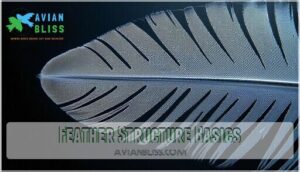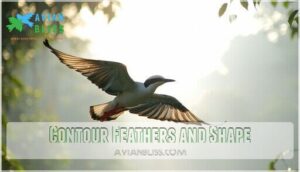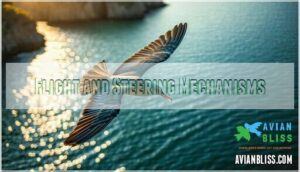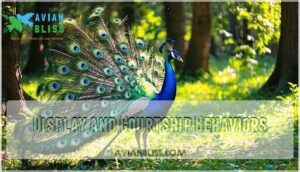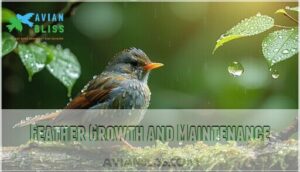This site is supported by our readers. We may earn a commission, at no cost to you, if you purchase through links.
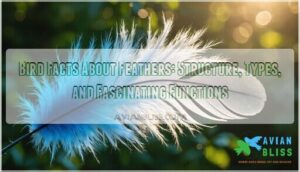
Each feather has a central rachis with barbs and tiny barbules that zip together, creating a lightweight yet durable structure.
They’re made of keratin, the same protein in your hair and nails, making them strong and flexible.
Birds have different feather types: flight feathers for soaring, down feathers for warmth, and contour feathers for that sleek, aerodynamic look.
Feathers also aid in courtship, camouflage, and even staying waterproof.
Next time you see a bird preening, it’s tuning up these incredible tools for its daily life.
Table Of Contents
- Key Takeaways
- Feather Structure Basics
- Types of Bird Feathers
- Feather Functions and Uses
- Feather Growth and Maintenance
- Feather Evolution and Adaptations
- Frequently Asked Questions (FAQs)
- What are the 5 functions of feathers?
- What do birds do to their feathers?
- What is special about feathers?
- What are the 5 feathers of birds?
- Do birds have feathers?
- What does a bird’s feather look like?
- What are the facts about feathers?
- How many birds have a coat of feathers?
- Why are feathers important to birds?
- How many feathers does an average bird have?
- Conclusion
Key Takeaways
- Birds use feathers for flight, warmth, waterproofing, and attracting mates, making them essential for survival.
- Feathers are made of lightweight but strong keratin, with barbs and barbules forming a durable, interlocking structure.
- Different feather types serve specific roles, like flight feathers for soaring, down feathers for insulation, and contour feathers for streamlined mobility.
- Birds meticulously preen to maintain feathers, aligning barbs, spreading waterproof oil, and ensuring optimal condition for flying and insulation.
Feather Structure Basics
When you look closely at a feather, you’ll notice it has a central shaft called the rachis, with barbs branching out like tree limbs.
These barbs connect through tiny hooks, or barbules, creating a smooth and flexible surface that’s perfect for flight and insulation.
Central Rachis and Barb
The central rachis is the backbone of bird feathers, providing both strength and flexibility.
Think of it as the feather’s "spine," made of keratin, giving feathers their lightweight durability.
Barbs sprout from the rachis in a precise arrangement, aiding feather aerodynamics. These barbs interlock like puzzle pieces, ensuring stability and smooth airflow—essential for flight and the feather structure’s overall performance.
The interlocking barbs are crucial as they ensure the feather maintains its shape and function, with the rachis acting as the central axis, providing durability.
Barbule and Vane Formation
Barbs connect through small barbules equipped with tiny hooks, creating interlocking mechanisms for feather strength.
This arrangement forms a flat, flexible vane, essential for bird flight and insulation.
Vane asymmetry adds precision, indispensable in steering and stability, it’s like nature’s Velcro—holding everything in place while staying lightweight.
Feather composition and feather development guarantee these structures work seamlessly across bird feathers, ensuring that the interlocking mechanisms and vane asymmetry function optimally.
Calamus and Papilla Function
Located at the base of a feather, the calamus anchors to the bird’s papilla.
This part is packed with sensory nerves, aiding in feather care and movement. The papilla’s blood supply and growth factors fuel feather growth.
Here’s why it matters:
- Supports feather replacement during molting.
- Enhances calamus flexibility.
- Enables calamus muscle attachment.
- Monitors feather development.
Keratin Composition and Properties
Moving from the calamus’s role, let’s talk keratin—a superstar protein in bird feathers.
Keratin guarantees strength and flexibility, letting feathers endure the demands of flight while staying light.
It binds pigments for vibrant colors and resists wear, though keratin degradation happens over time.
This protein structure is a marvel of feather biology, balancing durability and feather composition for survival.
Types of Bird Feathers
Feathers come in many types, each with a specific role, from flight to insulation.
By exploring these fascinating structures, you’ll see how they help birds survive and thrive in their environments.
Wing Feathers and Flight
Flight feathers are built for performance. These strong, stiff feathers on a bird’s wings are key to mastering the skies.
They enable precise movements through clever aerodynamics and feather strength. Flight mechanics vary based on wing shape and style.
- Long primary feathers for speed.
- Shorter secondary feathers for stability.
- Flexible feathers adjust mid-air for smooth flying.
Tail Feathers and Balance
Tail feathers are incredible tools for bird flight!
Acting as rudders, they handle steering and maneuvering, helping birds turn sharply or brake smoothly before landing.
Thanks to their tail feather aerodynamics and balance in perching, birds stay agile.
Even asymmetry, like losing a feather, doesn’t stop most birds, as they adapt quickly to maintain control.
Feather functions are amazing!
They are crucial for the bird’s ability to fly, and their aerodynamics play a significant role in this process.
Contour Feathers and Shape
Contour feathers define a bird’s shape, helping with streamlined flight and species identification.
They create aerodynamic contours for smooth air movement and display vibrant camouflage colors for survival.
Here’s why they’re key:
- Protects birds from weather with tough outer layers.
- Camouflages using patterns to outsmart predators.
- Assists in bird flight by reducing drag and enhancing aerodynamics.
Semiplume Feathers and Insulation
Semiplume feathers are like nature’s cozy blanket, bridging functionality between down and contour feathers.
They excel at insulation efficiency thanks to their loose structure and feather density, trapping air close to a bird’s skin, maintaining steady body temperature.
These feathers also contribute to contouring, fluffing up for displays.
Imagine them as the secret weapon for thermal regulation.
They achieve this, in part, because of their plumulaceous structures.
Here’s a quick breakdown:
| Feature | Purpose | Effect |
|---|---|---|
| Loose Structure | Traps warm air | Better insulation |
| Hidden Placement | Under contour feathers | Extra comfort |
| Flexibility | Adapts to movement | Thermal regulation |
Down Feathers and Thermoregulation
In terms of keeping warm, down feathers are a bird’s secret weapon.
They trap air close to the skin, providing insulation even in freezing weather.
Here’s why they’re incredible:
- Down insulation: Keeps birds warm by retaining body heat.
- Nestling thermoregulation: Essential for young chicks.
- Waterfowl adaptations: Waterproof yet warm.
- Feather density: Maximizes temperature regulation.
Feather Functions and Uses
Feathers aren’t just for flying—they’re multi-tools that help birds survive and thrive in fascinating ways.
Feathers are nature’s ultimate tools, blending flight, warmth, and dazzling displays into essential elements of avian survival.
From staying warm on snowy days to impressing mates with spectacular displays, feathers play a role in nearly every part of a bird’s life, making them a crucial part of their overall survival and thrive.
Flight and Steering Mechanisms
Flight feathers work like an airplane’s wing, with their airfoil design creating lift.
Birds steer using tail feathers, adjusting for turns or quick stops. Feather aerodynamics and strong flight muscles keep them soaring smoothly.
Wing shape decides speed and agility—think hummingbird versus eagle. Cambered wings generate lift by manipulating airflow pressure.
It’s nature’s engineering at its best, proving feathers aren’t just for show, with feather aerodynamics playing a crucial role.
Display and Courtship Behaviors
Bird courtship is a visual feast, showcasing plumage signals and vibrant coloration effects.
Male birds flaunt feather displays, including striking crest displays and elaborate tail ornaments, to win mates.
Mating rituals like dances and synchronized movements highlight strength and health.
Birds may even use specialized feather products to enhance their displays.
Famous examples include peacocks’ dazzling tail displays and birds-of-paradise twisting their feathers into gravity-defying shapes—proving love really does take effort!
Insulation and Weatherproofing
Bird feathers are nature’s snuggly blankets and raincoats.
Down feathers, with their fluffy structure and dense layers, trap air for amazing thermal regulation.
Birds preen daily, spreading preen oil to enhance water repellency.
This clever waterproofing stops feathers from soaking, keeping birds dry in rain.
Feather adaptations like density guarantee insulation, proving these lightweight marvels are perfect for staying cozy and weatherproofed.
To purchase quality down products, many retailers are available.
Camouflage and Protection Strategies
How do bird feathers pull off the ultimate vanishing act? Through clever coloration strategies like disruptive patterns and mimicry feathers, they trick predators’ eyes.
Feather types work together—contour feathers hide shadows, while feather colors blend into surroundings. For specialized needs, birds may use camouflage feather products to further enhance their concealment.
Structural defenses, like tough contour layers, add protection. Feather camouflage isn’t just survival; it’s bird artistry, turning them into nature’s ultimate escape artists.
Feather Growth and Maintenance
Feather growth starts in tiny skin follicles, where keratin builds intricate structures like barbs and barbules.
To keep feathers in top shape, birds preen them daily, spreading oils for protection and flexibility.
The Growth Process and Stages
Feathers grow from follicles in stages, starting as pinfeathers with a protective sheath.
Growth bars track daily development, showing how nutrition impacts a bird’s feather quality.
Molting stages replace old feathers, ensuring they’re ready for insulation, flight, or display.
Feather imping, or repairing broken ones, can even restore flight.
Down development helps young birds stay warm while their plumage matures, which is crucial for their survival.
Branching Patterns and Development
As feathers grow, tiny, tree-like branching patterns emerge from the rachis.
Barbule development, guided by branching genes, creates intricate feather patterns essential for flight and insulation.
From the feather bud, precision in keratin synthesis shapes these structures.
This complexity highlights avian biology’s marvels, where feather molting renews these designs, showcasing the remarkable evolution of bird feathers over time.
Protective Sheath and Feather Maturation
Young feathers emerge wrapped in a protective sheath full of blood vessels, called a blood feather. This allows nutrients to help them grow.
Over time, the sheath flakes away in the keratinization process, hardening the feather for its functions. Watching feather unfurling signals its maturation timeline, as soft beginnings transform into the sleek, sturdy tools needed for feather molting and bird survival.
Balanced diets are also essential for feather health.
- Tiny sheaths protect fragile feathers.
- Blood feathers heal like growing fingernails.
- Keratin adds strength to each feather.
- Feathers “unfurling” are like nature’s origami.
Preening and Maintenance Techniques
Think of preening as a bird’s spa day.
Birds use preen oil to keep feathers waterproof and flexible, while powder down helps with cleaning.
Their feather maneuvering guarantees every barb aligns perfectly.
Preening behavior is essential for feather maintenance, and imping techniques can repair broken feathers.
Regular bathing behaviors further support feather cleaning, keeping bird feathers spotless and functional.
Feather Evolution and Adaptations
Feathers came from tiny, fluffy coverings on dinosaurs, eventually evolving into the highly specialized structures birds use today for flight, warmth, and display.
Fossils and modern research show how these remarkable adaptations allowed birds to thrive in nearly every environment on Earth, making them a key part of the planet’s ecosystem.
Early Feathers and Theropod Dinosaurs
Did you know dinosaurs had a flair for plumage? The fossil record shows theropods, like Velociraptors, sported protofeathers—simple, hair-like filaments.
These early adornments likely helped with insulation, camouflage, or showing off to mates. Feather origins trace back to these prehistoric creatures, linking dinosaurs to modern bird evolution.
It’s amazing that dinosaur feathers sparked the intricate bird plumage we see today! These early feathers eventually evolved into complex structures, including pennaceous flight feathers, which is a key part of their evolution.
Evolution of Flight Capable Feathers
You’ve got dinosaur feathers to thank for today’s soaring birds.
Over millions of years, evolutionary pressures shaped these fluffy beginnings into the aerodynamic marvels we call flight feathers.
Transitional fossils reveal how early birds balanced lightweight structures with strength for lift and glide.
These adaptations paved the way for the skies to become nature’s greatest stage.
The key features of these feathers include:
- Near-weightless keratin composition
- Barbs enhancing air resistance
- Interlocking barbules for strength
- Curved shapes for lift generation
- Gradual changes in fossil records
Fossil Evidence and Evo-Devo Research
Feather evolution isn’t just fascinating—it’s written in stone.
Feathers hold the story of evolution, etched in ancient stone and brought to life in today’s avian wonders.
The fossil record reveals dinosaurs sporting early forms of feathers, highlighting their role in thermoregulation and displays.
Feather paleontology, boosted by evo-devo research, shows how developmental tweaks shaped feathers into flight-ready tools.
Imagine ancient dinosaurs flaunting fluff that paved the way for birds, connecting millions of years of evolution into today’s avian wonders!
Developmental Origins of Feathers and Diversity
Long before flight, dinosaur feathers likely evolved for warmth and display, setting the stage for today’s bird anatomy.
Feather genes played a pivotal role in creating structures as diverse as insulating down and aerodynamic flight feathers.
Keratin gave strength and versatility, enabling remarkable avian development, which highlights evolution’s creativity, blending function, beauty, and survival into fascinating features that showcase the diversity origins of bird feathers.
Frequently Asked Questions (FAQs)
What are the 5 functions of feathers?
Feathers do incredible work!
They help birds fly, stay warm, blend in to avoid predators, attract mates with vivid displays, and even repel water.
It’s like having a Swiss army knife in bird form!
What do birds do to their feathers?
Like knights polishing armor, birds preen their feathers to stay flight-ready.
They use their beaks to spread oil, keep feathers clean, align barbs, and guarantee waterproofing—meticulous care that’s part hygiene, part survival, and all instinct.
What is special about feathers?
Bird feathers are incredible multitaskers, helping with flight, insulation, mate attraction, and even communication.
Made of strong, lightweight keratin, they come in dazzling colors and shapes, often signaling health, survival skills, or social status.
What are the 5 feathers of birds?
Think of feathers as a bird’s Swiss Army knife—each type serves a unique purpose.
Birds have flight feathers for soaring, contour for shape, down for warmth, semiplume for extra insulation, and bristles for protection.
Do birds have feathers?
Absolutely, birds have feathers!
These unique structures both help them fly and keep them warm, impress potential mates, and even blend into their surroundings.
Feathers are like nature’s Swiss Army knife for birds!
What does a bird’s feather look like?
Imagine a tiny tree—feathers have a central shaft, with barbs branching out like limbs.
These barbs split into microscopic barbules, locking like Velcro, forming a lightweight, durable, and intricate structure perfect for flight and insulation.
What are the facts about feathers?
Feathers aren’t just for looks; they’re multi-tools.
They help birds fly, stay warm, and even show off for mates.
Made of keratin, they’re lightweight yet strong, with intricate structures like barbs and barbules.
How many birds have a coat of feathers?
Like the Earth’s diverse landscapes wrapped in unique textures, every bird species—nearly 10,000 worldwide—sports a coat of feathers.
These are essential for flight, warmth, and communication, making them truly one-of-a-kind aviator wardrobes!
Why are feathers important to birds?
Feathers let birds fly, stay warm, and keep dry.
They’re lightweight yet strong, perfect for soaring or gliding.
Plus, feathers help birds attract mates, camouflage from predators, and even communicate—talk about multitasking with style!
How many feathers does an average bird have?
The average bird carries about 1,500 to 25,000 feathers, depending on its size and species.
Tiny hummingbirds may wear just around 1,000, while larger birds, like swans, sport tens of thousands for insulation and flight!
Conclusion
It’s ironic how something as delicate-looking as a feather is a powerhouse for survival.
These intricate structures, made of keratin, turn birds into masters of flight, warmth, and disguise.
From the sleek contour feathers that shape a bird’s body to the insulating down feathers shielding it from cold, each type serves a essential purpose.
Next time you marvel at a preening bird, remember—you’re witnessing evolution’s masterpiece, a true example of nature’s ingenious design, where bird facts about feathers truly highlight the complexity of it all.
- https://www.audubon.org/content/miracle-miracles
- https://news.nationalgeographic.com/2016/04/160405-dinosaurs-feathers-birds-museum-new-york-science/
- https://en.wikipedia.org/wiki/Bird_wing
- https://www.britannica.com/science/feather
- https://www.ualberta.ca/admissions-programs/online-courses/paleontology-theropod-dinosaurs.html

